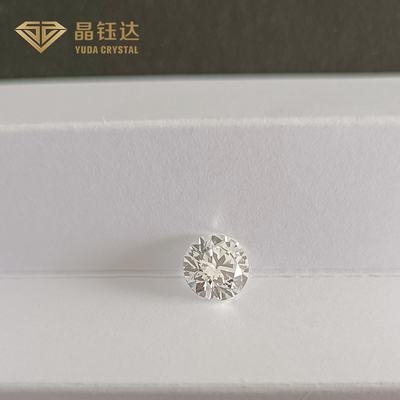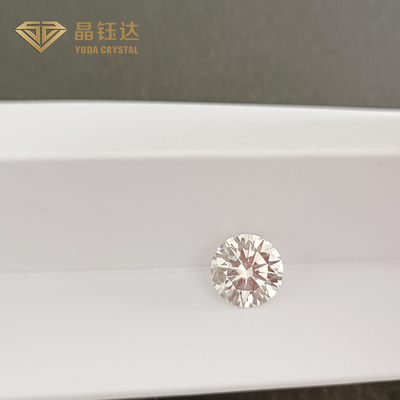1.0-4.0 Carat DEFGH VS SI Lab Grown HPHT Loose Diamonds For Jewelry
Lab Grown HPHT Diamonds Description
The diamond is considered to be the hardest material in the world. Mohs hardness is divided into 10 levels, including diamond as the highest level. Since it has been known that diamonds are made of pure carbon, more and more people are studying diamonds at high temperature and pressure in the laboratory. At present, the high temperature and high pressure lab diamond raw materials industry development is rapid, widely used in various industries and processing industry.
Although laboratory cultivation of diamond is with natural diamond different environment and conditions, but the natural diamond and laboratory diamonds are crystals of pure carbon, their physical properties, chemical properties, crystal structure and optical properties are the same. Lab-grown diamonds and mined diamonds are real diamonds.
Artificial diamond, in high temperature and high pressure diamond is often referred to as laboratory, by imitating the natural diamond crystallization process. Natural diamonds are formed in the natural environment, often mixed with other elements together, and makes some natural diamonds are not completely transparent, can present a particular color. For example, some have pink diamonds, some have a touch of blue, and some have light yellow. Diamonds are grown in the laboratory under high temperature and pressure. Impurity less than natural diamond, so more pure and transparent.
Natural diamond need millions of years to form. Before the eruption, about 150 to 200 kilometers deep underground lava Wells can slowly cooling in the crater, usually because the crater was blocked. The pressure of pure carbon material is 4.5 * 10 ^ 6 ~ 9 Pa. When the temperature dropped to 1000 ~ 1250 ℃, the formation of natural diamond crystals. Diamonds are formed under physical and chemical conditions in some parts of the earth.
However, under natural conditions, producing natural diamonds in the laboratory can now be simulated using high temperature and pressure (HPHT) or chemical vapor deposition (CVD) techniques to produce laboratory-produced gem-grade diamonds in just a few weeks.
Parameters Of Lab Grown HPHT CVD Diamonds
| Product Name |
Synthetic (Lab created) Loose Diamond |
| Material |
Lab Grown Loose Diamond |
| Diamond Color |
DEFGH |
| Diamond Shape |
Round |
| Diamond Technology |
HPHT |
| Diamond Cut |
Cut |
| Payment Terms |
100% Payment In Advance |
| Diamond Carat Weight |
0.1CT-4CTS |
| Diamond Clarity |
VVS VS SI |
| Shipping way |
DHL, FedEx, SF Express, UPS, EMS, TNT etc |
| M.O.Q |
Negotiable |
| Delivery Time |
1-7 Working Days Depends On Quantity |
| Payment Methods |
T/T, PayPal, Western Union, Bank Transfer |
| Used |
Jewelry (necklace,ring,earring) |
| Application |
For Sale |
| Place Of Origin |
Zhengzhou, China |
Characteristics Of Lab Grown HPHT Diamonds
Laboratory cultivation of diamond is bred in the laboratory. People use advanced equipment to simulate the natural diamond formation of the environment. Laboratory-grown diamonds are usually produced in a lab for several weeks. Natural diamonds are created by nature, the result of billions of years of high temperature and pressure. Both on the chemistry of the difference is the same.
So how do you distinguish between laboratory cultivation of diamond and natural diamond?
Laboratory cultivation of diamond and natural diamond there was no significant difference. Even professional gemologists also need special equipment to identify them. By magnifying, professionals will be able to recognize in the lab, growth and production of diamond inclusions nuances.
| The Difference Between Lab Diamond And Natural Diamond |
| Attribute |
Lab-Created Diamonds |
Natural diamond |
Distinction |
| Chemical composition |
C(carbon) |
C(carbon) |
No |
| Refractive index |
2.42 |
2.42 |
No |
| Relative density |
3.52 |
3.52 |
No |
| Dispersion |
0.044 |
0.044 |
No |
| Hardness value |
90 GPA |
90 GPA |
No |
| Thermal conductivity |
2*103 W/M/K |
2*103 W/M/K |
No |
| Thermal property |
0.8*10-6 K |
0.8*10-6 K |
No |
| Light transmittance |
DEEP UV TO FAR TR |
DEEP UV TO FAR TR |
No |
|
Resistivity
|
1016 OHM-CM
|
1016 OHM-CM
|
No
|
|
Compressibility
|
8.3*10-13 M2/N
|
8.3*10-13 M2/N
|
No
|
From a scientific point of view, synthetic diamond and natural diamond exactly the same, the only difference is that the formation of their position.
Loose Lab Grown HPHT Diamonds Details


 Your message must be between 20-3,000 characters!
Your message must be between 20-3,000 characters! Please check your E-mail!
Please check your E-mail!  Your message must be between 20-3,000 characters!
Your message must be between 20-3,000 characters! Please check your E-mail!
Please check your E-mail! 







